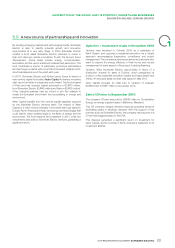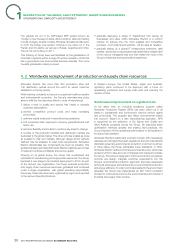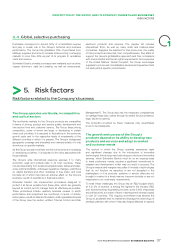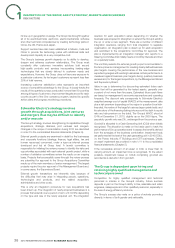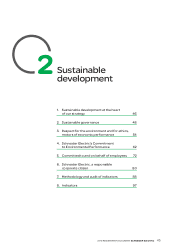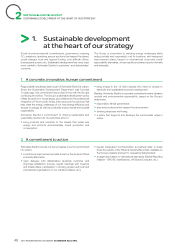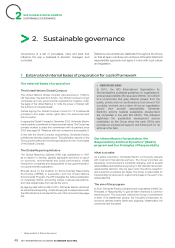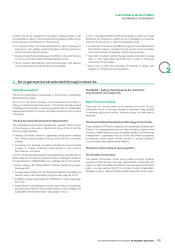APC 2010 Annual Report Download - page 42
Download and view the complete annual report
Please find page 42 of the 2010 APC annual report below. You can navigate through the pages in the report by either clicking on the pages listed below, or by using the keyword search tool below to find specific information within the annual report.
DESCRIPTION OFTHEGROUP, ANDITSSTRATEGY, MARKETS ANDBUSINESSES
1RISK FACTORS
Information systems risk
The Group operates, either directly or through service providers,
a wide range of highly complex information systems (servers,
networks, applications, databases, etc.) that are essential to the
effi ciency of its sales and manufacturing processes. Failure of any of
these hardware or software systems, a fulfi llment failure by a service
provider, human error or computer viruses could adversely affect
the quality of service offered by the Group.
The Group regularly examines alternative solutions to protect
against this type of risk and has developed contingency plans to
mitigate the effects of any information system failure. Dedicated
governance structures have been set up to manage relations with
service providers responsible for outsourced IT systems operations.
Problems may also be encountered during the deployment of new
applications or software. In particular, in the last few years, the
Group has developed an ERP under SAP (bridge), which it started
to roll out in 2008. This roll-out process was carried out fully or
partially in 17 countries in 2009 and 2010, and will continue in 2011
and over several more years, depending on strategic, technical and
economic priorities.
In view of the project’s complexity, extensive functionalities and its
worldwide deployment, a dedicated governance and cost control
structure has been set up to track attainment of project milestones
and limit the related risks.
However, despite the Group’s policy of establishing governance
structures and contingency plans, there can be no assurance
that information systems projects will not be subject to technical
problems or execution delays. While it is diffi cult to accurately
quantify the impact of any such problems or delays, they could
have an adverse effect on inventory levels, service quality and,
consequently, the Group’s fi nancial results.
Market risks
Interest rate risk
The Group is exposed to risks associated with the effect of changing
interest rates. Interest rate risk on borrowings is managed at
Group level, based on consolidated debt and according to market
conditions. The core aim of interest rate management policies is to
optimise overall borrowing costs. Most bond debt is fi xed rate. At
December31, 2010, 84% of gross debt was fi xed rate.
Maturities of fi nancial assets and liabilities are presented in note26
to the consolidated fi nancial statements.
A 1% change in interest rates would have an impact of around
EUR24million on the Group’s fi nancial expense.
The fi nancial instruments used to hedge the exposure of the
Group to fl uctuations in interest rates are described in note 26
to the consolidated fi nancial statements for the year ended
December31, 2010.
The Group’s international operations expose it
to the risk of fluctuations in foreign exchange
rates
Because a signifi cant proportion of transactions are denominated in
currencies other than the euro, the Group is exposed to risk arising
from changes in exchange rates. If the Group is not able to hedge
them, fl uctuations in exchange rates between the euro and these
currencies can have a signifi cant impact on its results of operations
and distort year-on-year performance comparisons.
The Group actively manages its exposure to currency risk to reduce
the sensitivity of earnings to changes in exchange rates. Hedging
programs mainly concern foreign currency receivables, payables
and operating cash fl ows, which are generally hedged by means of
forward purchases and sales.
Depending on market conditions, risks in the main currencies may
be hedged based on recurring forecast fl ows using contracts that
expire in 12months or less.
The Group’s currency hedging policy is to protect subsidiaries against
risks on all transactions denominated in a currency other than their
functional currency. More than twenty currencies are involved, with
the US dollar, Hong Kong dollar and UK pound representing the
most signifi cant sources of risk. The fi nancial instruments used to
hedge the exposure of the Group to fl uctuations in exchange rates
are described in note26 to the consolidated fi nancial statements for
the year ended December31, 2010 (Chapter 5).
In 2010, revenue produced in foreign currencies amounted to
EUR14.1 billion, including around 4.8 billion in US dollars and
2.2billion in Chinese yuans.
The main exposure of the Group in terms of currency exchange
risks is related to the US dollar and to currencies infl uenced by the
US dollar. The Group estimates that in the current structure of its
operations, a 5% increase of the euro compared to the US dollar
would have a negligible impact on operating margin (translation
effect of EUR30million on EBITA).
Equity risk
Exposure to equity risk primarily relates to treasury stock and shares
in AXA. These positions are not hedged. At December31, 2010,
the AXA shares’ market value exceeded their acquisition cost.
An increase in raw material prices could have
negative consequences
The Group is exposed to fl uctuations in energy and raw material
prices (in particular steel, copper, aluminum, silver, lead, nickel, zinc
and plastics). If the Group is not able to hedge, compensate or pass
2010 REGISTRATION DOCUMENT SCHNEIDER ELECTRIC40





